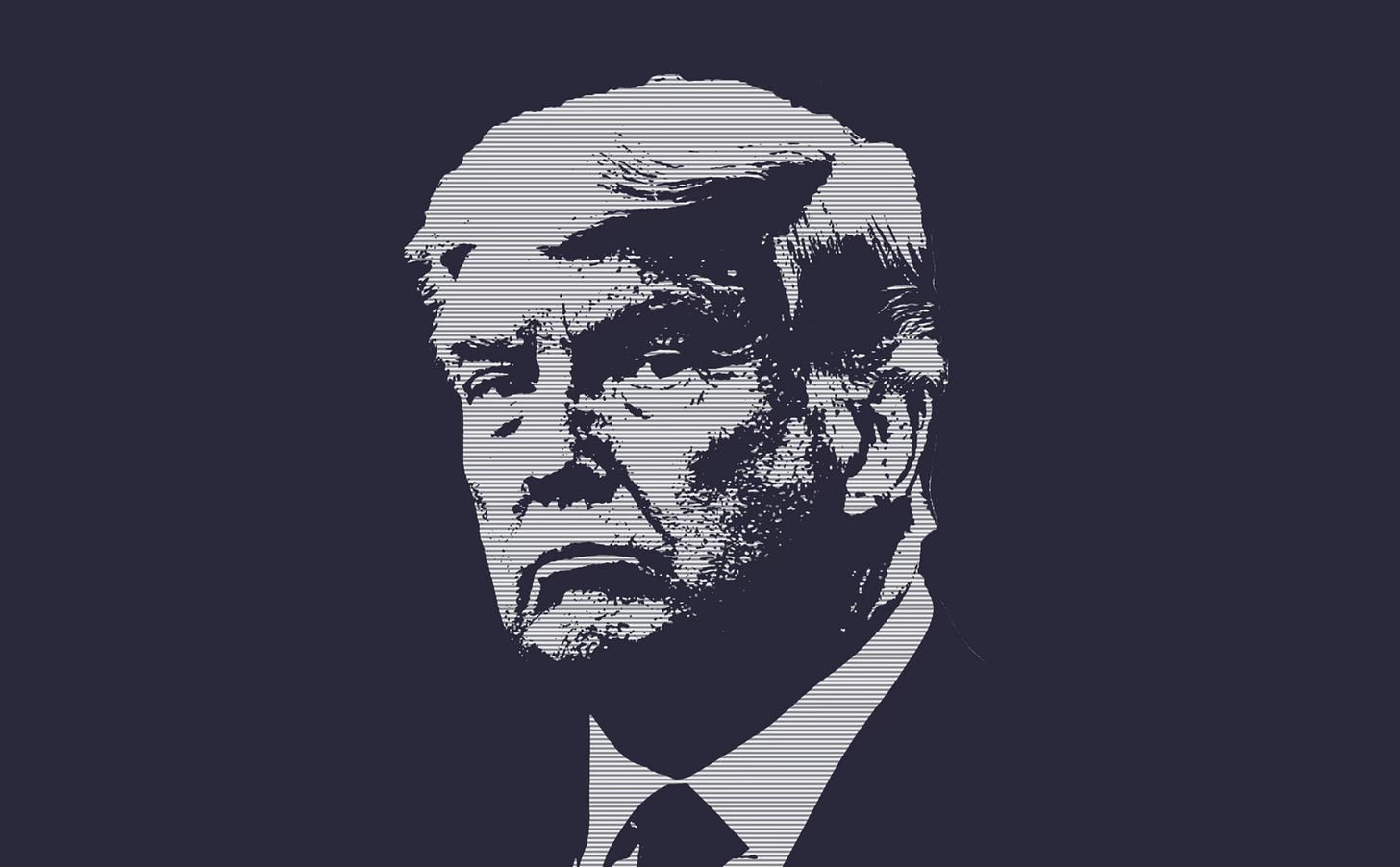Which Variety of Authoritarianism Is Trumpism?
It shares features with fascism but its closest ideological kin at the moment is Orbánism
“When Fascism came into power, most people were unprepared, both theoretically and practically. They were unable to believe that man could exhibit such propensities for evil, such lust for power, such disregard for the rights of the weak, or such yearning for submission. Only a few had been aware of the rumbling of the volcano preceding the outbreak.” — Erich Fromm, Escape from Freedom
The interminable presidential election campaign has generated a discourse as predictable as is (sadly) important: Is Trump the second coming of Adolf Hitler? Op-ed after op-ed has weighed in on whether Trumpism is fascistic. These follow on the heels of lengthy academic and journalistic debates in tomes—like Did It Happen Here?: Perspectives on Fascism and America and The Wannabe Fascists: A Guide to Understanding the Greatest Threat to Democracy—that ponder whether Trump is better called a fascist, an authoritarian populist, or countless other neologisms. New Netflix series like Hitler and the Nazis: Evil On Triumph add fuel to the claim that U.S. 2024 is Weimar 1933, with commentators repeating how Hitler wanted to “Make Germany Great Again” and warning that history can repeat itself.
Not to be outdone, Trump and his supporters have fired back by describing Joe Biden as running a “Gestapo” administration and claiming liberals want to establish a nightmarish “total state” where presumably everyone is forced to watch RuPaul while being served only Bud Light. More recently, Trump called Kamala Harris a “fascist” (and a communist). And back in the day, even current Never Trumpers like Jonah Goldberg flirted with the “Obama is Hitler” schtick.
What Is Fascism?
The Trump-fascism question is very important. There’s of course a vapid reductio ad Hitlerum argument which manically frames any politician or movement one doesn’t like as the resurrection of Nazism. But Trump has long courted far-right movements and figures like the Proud Boys and Steve Bannon, and the love has very much been reciprocated.
Part of the difficulty lies in defining what Stanley Payne calls “generic fascism” in his 1980 Fascism: Comparison and Definition—a set of features common to all fascist movements across space and time which allow us to recognize one when we see it. This is made all the more difficult by the fact that very few far-right groups and politicians would wish to be identified as fascist (in contrast to pre-World War II) and will resist any such characterization, even when it might be warranted. Consequently, any ascription of the label will likely be imposed by enemies of both fascism and the group so labeled, making the process incredibly controversial.
In his 2004 book, Fascists, sociologist Michael Mann defines fascism as the “pursuit of a transcendent and cleansing nation-statism through paramilitarism.” Historian Robert O. Paxton defines it as a:
form of political behavior marked by obsessive preoccupation with community decline, humiliation or victimhood, and the compensatory cults of unit, energy, and purity, in which a mass-based party of committed nationalist militants, working in uneasy but effective collaboration with traditional elites, abandons democratic liberties and pursues with redemptive violence and without ethical or legal restrains, goals of internal cleaning and external expansion.
But probably the most widely accepted definition is given by historian and political theorist Roger Griffin in his 1991 classic The Nature of Fascism. Griffin defines fascism as a “genus of political ideology whose mythic core in its various permutations is a palingenetic form of populist ultranationalism.” The fascist projects the myth of an “ultranation” which is the source of real and even transcendent strength and belonging for its (legitimate) “people.” The ultranation is then anxiously portrayed as threatened by enemies within and without who are leading a process of decay. These enemies vary widely depending on where the fascist movement arises and can be national or international. But it is typically a combination of those within perceived as “foreign,” international opponents, leftists, liberals, democrats, feminists, Marxists, and any others who are perceived to sap the will of the people to renew the ultranation.
Is Trumpism Populist Fascism?
More complex is fascism’s relationship with conservatives, who are often also presented as antagonists defending a sclerotic and decayed order which is no longer worth conserving and bears a lot of blame for the process of decline. This is echoed in some of the recent declarations of moderate Republicans as “cuckservatives” or “Republican in Name Only.” Nevertheless, fascists will often form alliances both tactical and ideological with conservative elites, as they did in Italy and Germany, to eliminate the left and shore up power. Once in power, fascists will typically invest extraordinary authority, historically in a male leader figure, who embodies the popular demotic will and so is entitled to sweeping powers that supersede the nebbish restrictions liberals like to impose on the executive branch. The leader and fascist party will then use these powers to try and rejuvenate the nation. They typically start by wiping out the enemies of the fascist party and any other undesirables; as Griffin points out, fantasies of revenge, usually but, crucially, not always impotent, are very common on the far right.
Grim stuff.
The question then becomes whether Trumpism coincides, at least closely enough, with generic fascism to warrant the most toxic label in the political arsenal? Experts are divided.
Paxton initially refrained from calling Trump a fascist before coming around post Jan. 6. Nazism expert Richard Evans opined that there are “strong echoes of fascism” in Trumpism, but not enough to call it the real deal. The contributors to this year’s Did it Happen Here? were divided. In his 2017 From Fascism to Populism in History, Federico Finchelstein splits the difference and claims that “macho populism” has a “fascist starting point, and yet populism is not fascism.” This is because Trump and other right-populist regimes have thus far refrained from establishing one-party dictatorships, even if they take measures to ensure elections are far from fair. Finchelstein points out populists often relish the energy and legitimacy that comes from winning the people’s vote. Personally, I’ve hesitated to call Trump a fascist—my own term has been a “post-modern conservative.” Though as the GOP has made more transparently authoritarian gestures from 2020 onwards, down through Trump calling his enemies “vermin,” it has felt more and more like time to pull out the F word.
Trumpism as Orbánism
One of the reasons I’ve hesitated to call Trump a fascist is, following Evans, it’s not clear to me that his ambition has ever been to establish the kind of “total” and militarized state lionized by Carl Schmitt, the German philosopher, Benito Mussolini, the Italian dictator, and Giovanni Gentile, Mussolini’s ghostwriter. In practice Evans, Payne, and others point out that neither the Italian or German fascist states ever achieved anything like the complete control of mind, body, and soul that they aimed for. But it was undeniably their long-term objective. As Mussolini and Gentile put it in The Doctrine of Fascism, the aim of fascism is “totalitarian, and the Fascist State—a synthesis and a unit inclusive of all values—interprets, develops, and potentates the whole life of a people.” Contemporary right populists from Trump to Orbán sometimes make gestures in that totalizing direction. But they just as frequently aim to negate politics and, simultaneously, do the converse: render it transcendent and all-consuming. For all their populism, in practice many of the GOP’s most influential moves have been to rely on or try to seize the least populist and demotic institutions in the state including the courts, the federal bureaucracy, the insular network of Republican operatives.
This isn’t to say things couldn’t move in a more totalizing direction in the event of a second Trump term. But the more immediate threat would likely be an effort to establish what Steven Levitsky and Lucan Way term a slide into “competitive authoritarianism” a lá Viktor Orbán’s Hungary.
This is not mere speculation. Orbán has long been a favorite of the GOP. In 2022, he was invited to speak at CPAC and has recently called on Trump to defeat the “progressive world spirit” on behalf of the global far right. Tucker Carlson, Rod Dreher, Steve Bannon, JD Vance, and other conservative movers and shakers have fawned over Orbán on more occasions than can be counted. And Trump himself has routinely expressed admiration for Orbán, including on the debate stage with Kamala Harris when he glowingly referred to the Hungarian autocrat as a “strongman”—ostensibly oblivious to the negative connotation.
It’s not hard to see the appeal for the American right. As chronicled five years ago by Paul Lendvai in Orbán: Europe’s New Strongman, Orbán began his career as a centrist activist militating against the once ruling Communist party. Ironically, he was once a crusader for open government and even received a George Soros funded scholarship to study at Oxford in 1989. Orbán won power in 1998 before losing it in 2002, which, by all accounts, stung. Swinging his Fidesz party sharply to the right, he won again in 2010. He then proceeded to rewrite the constitution several times to concentrate power in the ruling party’s hands, largely took control of the courts and media, gerrymandered electoral districts, and marginalized the opposition as much as possible.
As Zack Beauchamp chronicles in The Reactionary Spirit, many of these changes were very different from the spectacular gestures of 20th-century fascist regimes. Rather than dramatic democratic overthrows, reforms were often concealed within wonkish policy changes or buried deep within seemingly mundane pieces of legislation. This made it difficult for the public to detect what was going on. Of course, Orbán loudly proclaimed he was still committed to democracy. But it was to an “illiberal democracy,” as he strikingly put it in a 2014 speech in Băile Tușnad:
In other words, the Hungarian nation is not simply a group of individuals but a community that must be organised, reinforced, and in fact constructed. And so in this sense the new state that we are constructing in Hungary is an illiberal state, a non-liberal state. It does not reject the fundamental principles of liberalism such as freedom, and I could list a few more, but it does not make this ideology the central element of state organisation, but instead includes a different, special, national approach.
Making Authoritarianism Great in America
Predictably, Orbán’s promise to build an “illiberal democracy” was a half-truth at best. Fidesz certainly adopted illiberal policies by the sackful: adopting a hardline stance against Syrian refugees fleeing the civil war, describing them as “Muslim invaders,” passing anti-LGBTQ legislation while suppressing freedom of expression, and railing against the EU’s rule of law requirements while still deciding to take billions in handouts from them. This illiberal zeal has rapidly annexed the “democratic” part of his project. While Orbán remains relatively popular (though there are signs that his support, which has not risen to 50% despite Fidesz’s supermajority in parliament, is softening) no one would call the Hungarian elections or the political process fair.
One can readily see how this Hungarian model would be enormously appealing for Trump’s GOP. In the past eight presidential elections it has won the popular vote all of once. On many metrics ranging from drug decriminalization to LGTBQ inclusion, the American public has become more liberal rather than less since the last time the GOP won the popular vote two decades ago in 2004.
The result, as Corey Robin has long observed, is that the GOP typically relies on the anti-majoritarian architecture of American institutions to win elections (or in Trump’s case, to actively undermine and game them) and advance its agenda.
All this aligns very well with the Hungarian approach to politics, which prefers insular moves towards autocracy that operate below the radar of public politics and typically avoids controversial gestures. On that basis, Trump’s calamitous decision to sic a violent mob at his opponents in 2021 must appear like a serious strategic error.
But if reelected, it seems quite likely that Trump and his party could move more determinedly in the direction of Hungarian competitive authoritarianism. The recent Trump v United States ruling signaled that the Supreme Court will grant Trumpism wide latitude from legal oversight for anything the president might do. The centerpiece of the right-wing Heritage Foundation’s Project 2025 is a plan to effectively remake the federal bureaucracy in MAGA’s image. And even if Trump has distanced himself from this project, it’s very unlikely he’d avoid the tempting charms of a supplicatory executive branch for long. His VP pick JD Vance has been profoundly influenced by a series of hard-right intellectuals and billionaires like Curtis Yarvin and Peter Thiel who call for an end to democracy. Selecting Vance was widely seen as an effort to signal to the MAGA faithful that Trump is planning to govern largely for them in the future.
Above all else a move to competitive authoritarianism is plausible because it relies on a more common human motivation than an instinct for political grandiosity: namely, apathy. If reelected, Trump has promised extraordinarily cruel policies like the mass deportation of millions, although it’s unlikely many Americans would want to support that, or even want to be seen to support it. But Trump won’t need support. All he’ll need is to minimize resistance and coast on the expectation that most of the population won’t notice or care what he is doing; or at least not enough to bother with it. Mass indifference usually facilitates more cruelty than the overt malice of the few in a society.
What do they say? History doesn’t repeat itself but it rhymes. It may be that America will one day come to a Weimar moment where genuine fascism beckons; Trump himself might bring about that moment. But, for now, American liberals and progressives should spend less time studying Berlin 1933 and more Budapest 2010.
I was teaching classes on democracy and the political right at Whitman College in 2020 and 2021. On Jan. 6, I enjoyed something most teachers yearn for but I never want to see again: my students emailing me and reaching out asking if American democracy was through and what the hell would happen in the next few years. I’m ashamed to say all I could tell them was I had no idea; I’d never gone through anything like this before.
One still can’t be sure because there are so many forces that can knock the natural trajectory of a movement. But if Trump is not stopped, he’ll hand MAGA authoritarianism an enduring competitive advantage and perhaps permanently debilitate its liberal democratic opponents.
Correction: An earlier version of this article mistakenly referred to the Jan. 6 attack as occurring in 2020 instead of 2021. We regret the error.
© The UnPopulist, 2024











This is important information and should be widely read for understanding the direction we seem to be headed in should the malign forces so desirous of this goal, win. That said, I wish this were more brief; more condensed so that eyes wouldn’t glaze over a third of the way through. I’m retired and have nothing better to do than read every word here but that is me. I know my history. I’ve lived quite a bit of it but others don’t and haven’t yet and I fear that the very ones who need to have this knowledge would scroll on by and miss what is written here.
This is just my observation. Make of it as you will. I have it filed to refer to later.
A very objective and insightful text regarding political theory and behaviours. Thanks!